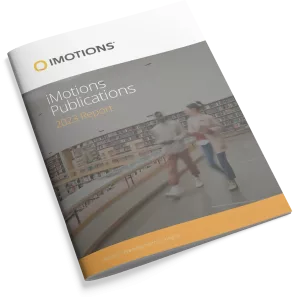-
Unique Object Characteristics Differentially Affect Visual Attention During Viewing of Dynamic Stimuli: The Influence of Location and Luminosity
Abstract: Understanding which characteristics of dynamic stimuli affect visual attention is crucial to usability research. We explored how object location and object luminosity differentially affect visual attention. Thirty-seven American participants viewed 34 Australian commercials, which were broken down by scene (N = 606) to identify all pertinent Areas of Interest (NAOIs = 2,695). Each AOI […] -
Automatic Analysis of Eye-Tracking Data for Augmented Reality Applications: A Prospective Outlook
Abstract: Eye-tracking technology is becoming easier and cheaper to use, resulting in its increasing application to numerous fields of research. Recent years have seen rapid developments in this area. In light of the foregoing, in the context of Cultural Heritage (CH), the definition of a modern approach to understand how individuals perceive art is challenging. […] -
Using Biometric Data to Assess Affective Response to Media Experiences
Abstract: The purpose of this work is to investigate a method of measuring emotional experience by interrupting video content every three minutes to self-report. We let 16 test participants watch the short-film Helium divided into a control group and an intervention group. The subjective experiences from nine subjects (the intervention group) were captured by self-reporting […] -
Eye-tracking technology, visual preference surveys, and urban design: preliminary evidence of an effective methodology
Abstract: Urban planners and designers use visual preference surveys to gather public opinion on potential designs for developments. Using eye-tracking technology, we administered a visual preference survey to a convenience sample to evaluate quantitatively the ways in which individuals process and rank images used in public settings for urban planning. We combined both a subjective […] -
Planning for the Subconscious
Abstract: The world is entering a new era of cognitive science that allows us to understand human behavior better than ever before. In fact, the Organization for Economic Co-Operation and Development recently labelled the 21st century the “Age of Biology,” noting the growing impacts of the ongoing life-science revolution, which the group predicts will change economies, […] -
Application of Hedonic Dynamics Using Multiple-Sip Temporal-Liking and Facial Expression for Evaluation of a New Beverage
Abstract: Drinking and eating are not a matter of a single sip or bite. Dynamic data gathered from multiple sip or bite, seem to be more reliable than simple sip/bite evaluation. However, methodologies and analyses based on multiple sips/bites have received little attention until recently. The present study tested an innovative approach to measure the […] -
Does the presence of a mannequin head change shopping behavior?
Mannequins are ubiquitous; this research investigates a specific element of mannequin style, namely, the presence or absence of a humanized head. Study 1 demonstrates that in physical stores, the presence of a humanized head enhances purchase intentions for the merchandise displayed on that mannequin. However, in online stores, mannequin styles with and without humanized heads […] -
Reducing Sketch Inhibition During Concept Generation: Psychophysiological Evidence of the Effect of Interventions
Abstract: This research investigated the effect of warm-up activities on cognitive states during concept generation. Psychophysiological tools including electroencephalography (EEG) and galvanic skin response (GSR) were used along with self-report measures (NASA TLX). Participants were divided into 3 test conditions: 1) no warm-up activity; 2) simple warm-up activities; 3) sketch-inhibition reducing activities. All participants did […] -
Enhancing the Professional Vision of Teachers: A Physiological Study of Teaching Analytics Dashboards of Students’ Repertory Grid Exercises in Business Education
This paper reports on a study of the design, development and evaluation of two teaching analytics dashboards that visualize students’ repertory grid exercise data. The technical objective of the dashboards is to support teachers to investigate and compare personal constructs and element ratings by students for given topics of study at the individual student, group […] -
Physiology-based recognition of Facial micro-expressions using EEG and identification of the relevant sensors by emotion
Abstract: In this paper, we present a novel work about predicting the facial expressions from physiological signals of the brain. The main contributions of this paper are twofold. a) Investigation of the predictability of facial micro-expressions from EEG. b) Identification of the relevant features to the prediction. To reach our objectives, an experiment was conducted […]
Research Report 2024
In-depth look at the scientific landscape as powered by iMotions software, showcasing groundbreaking research and the impact of our tools in various scientific and industrial fields.

iMotions Science Resources
Looking for white papers, validation reports or research show casing iMotions Multimodal capabilities?
Share Your Research

850+ universities worldwide with an iMotions human behavior lab
73 of the top 100 highest ranked universities
710+ published research papers using iMotions
iMotions is used for some of the most interesting human behavior research studies carried out by top researchers around the world. Contact us to have your publication featured here.
The authors of these publications have used iMotions as a software tool within their research.
“Software should be cited on the same basis as any other research product such as a paper or a book; that is, authors should cite the appropriate set of software products just as they cite the appropriate set of papers” (Katz et al., 2020).
We therefore encourage you to cite the use of iMotions where appropriate.
How to cite iMotions
APA
iMotions (10), iMotions A/S, Copenhagen, Denmark, (2024).
Note: adjust the version and year where relevant.
5 Most Popular Blogs
Learn How to Conduct Human Behavior Research with iMotions
Publications
Read publications made possible with iMotions
Blog
Get inspired and learn more from our expert content writers
Newsletter
A monthly close up of latest product and research news

